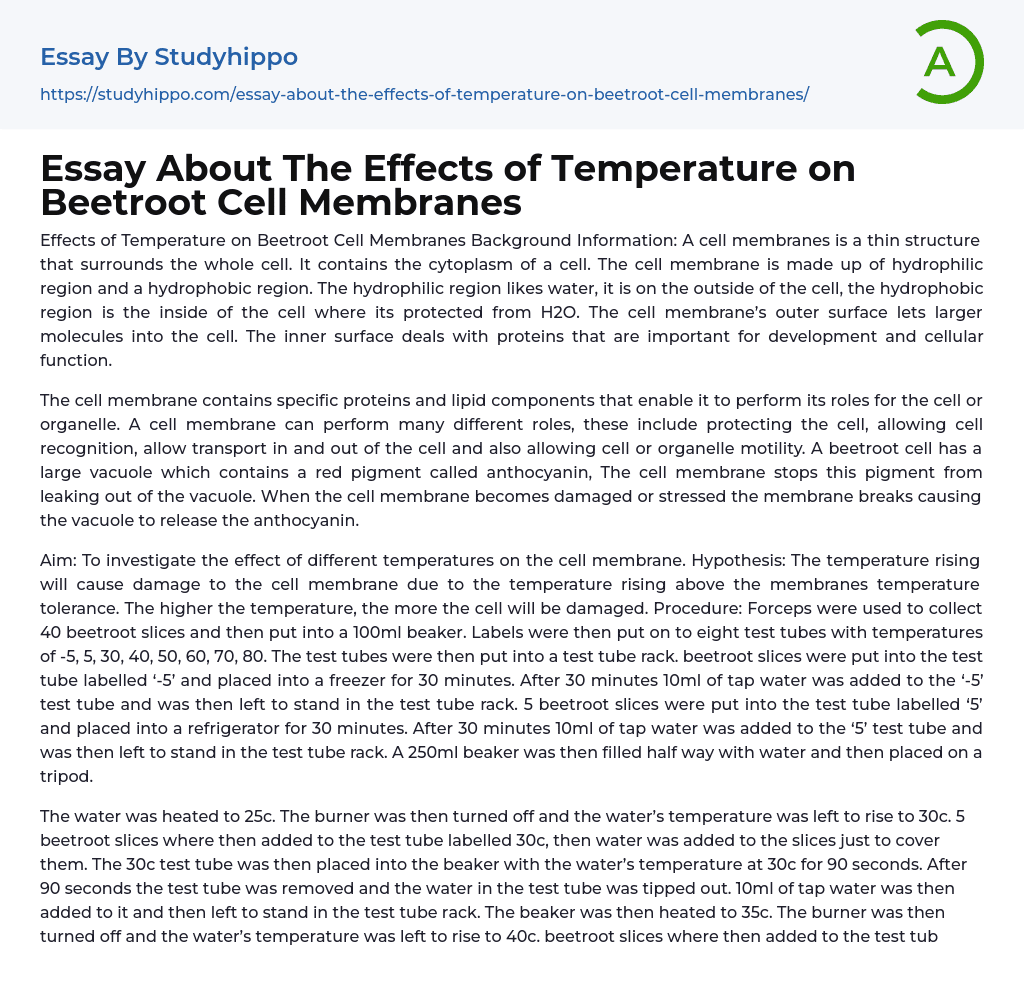

Essay About The Effects of Temperature on Beetroot Cell Membranes
Effects of Temperature on Beetroot Cell Membranes Background Information: A cell membranes is a thin structure that surrounds the whole cell. It contains the cytoplasm of a cell. The cell membrane is made up of hydrophilic region and a hydrophobic region. The hydrophilic region likes water, it is on the outside of the cell, the hydrophobic region is the inside of the cell where its protected from H2O. The cell membrane’s outer surface lets larger molecules into the cell. The inner surface deals with proteins that are important for development and cellular function.
The cell membrane contains specific proteins and lipid components that enable it to perform its roles for the cell or organelle. A cell membrane can perform many different roles, these include protecting the cell, allowing cell recognition, allow transport in
...and out of the cell and also allowing cell or organelle motility. A beetroot cell has a large vacuole which contains a red pigment called anthocyanin, The cell membrane stops this pigment from leaking out of the vacuole. When the cell membrane becomes damaged or stressed the membrane breaks causing the vacuole to release the anthocyanin.
Aim: To investigate the effect of different temperatures on the cell membrane. Hypothesis: The temperature rising will cause damage to the cell membrane due to the temperature rising above the membranes temperature tolerance. The higher the temperature, the more the cell will be damaged. Procedure: Forceps were used to collect 40 beetroot slices and then put into a 100ml beaker. Labels were then put on to eight test tubes with temperatures of -5, 5, 30, 40, 50, 60, 70, 80. The test tubes were then put into
a test tube rack. beetroot slices were put into the test tube labelled ‘-5’ and placed into a freezer for 30 minutes. After 30 minutes 10ml of tap water was added to the ‘-5’ test tube and was then left to stand in the test tube rack. 5 beetroot slices were put into the test tube labelled ‘5’ and placed into a refrigerator for 30 minutes. After 30 minutes 10ml of tap water was added to the ‘5’ test tube and was then left to stand in the test tube rack. A 250ml beaker was then filled half way with water and then placed on a tripod.
The water was heated to 25c. The burner was then turned off and the water’s temperature was left to rise to 30c. 5 beetroot slices where then added to the test tube labelled 30c, then water was added to the slices just to cover them. The 30c test tube was then placed into the beaker with the water’s temperature at 30c for 90 seconds. After 90 seconds the test tube was removed and the water in the test tube was tipped out. 10ml of tap water was then added to it and then left to stand in the test tube rack. The beaker was then heated to 35c. The burner was then turned off and the water’s temperature was left to rise to 40c. beetroot slices where then added to the test tube labelled 40c, then water was added to the slices just to cover them.
The 40c test tube was then placed into the beaker with the water’s temperature at 40c for 90 seconds. After 90 seconds the test tube was removed
and the water in the test tube was tipped out. 10ml of tap water was then added to it and then left to stand in the test tube rack. The beaker was then heated to 45c. The burner was then turned off and the water’s temperature was left to rise to 50c. 5 beetroot slices where then added to the test tube labelled 50c, then water was added to the slices just to cover them.
The 50c test tube was then placed into the beaker with the water’s temperature at 50c for 90 seconds. After 90 seconds the test tube was removed and the water in the test tube was tipped out. 10ml of tap water was then added to it and then left to stand in the test tube rack. The beaker was then heated to 55c. The burner was then turned off and the water’s temperature was left to rise to 60c. 5 beetroot slices where then added to the test tube labelled 60c, then water was added to the slices just to cover them. The 60c test tube was then placed into the beaker with the water’s temperature at 60c for 90 seconds.
After 90 seconds the test tube was removed and the water in the test tube was tipped out. 10ml of tap water was then added to it and then left to stand in the test tube rack. The beaker was then heated to 65c. The burner was then turned off and the water’s temperature was left to rise to 70c. 5 beetroot slices where then added to the test tube labelled 70c, then water was added to the slices just to cover
them. The 70c test tube was then placed into the beaker with the water’s temperature at 70c for 90 seconds. After 90 seconds the test tube was removed and the water in the test tube was tipped out. 0ml of tap water was then added to it and then left to stand in the test tube rack. The beaker was then heated to 75c.
The burner was then turned off and the water’s temperature was left to rise to 80c. 5 beetroot slices where then added to the test tube labelled 80c, then water was added to the slices just to cover them. The 80c test tube was then placed into the beaker with the water’s temperature at 80c for 90 seconds. After 90 seconds the test tube was removed and the water in the test tube was tipped out.



